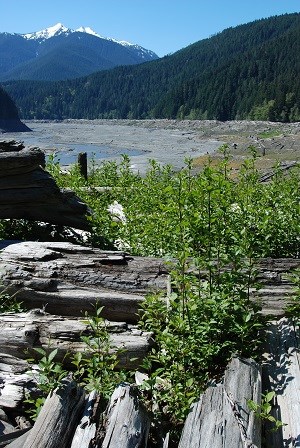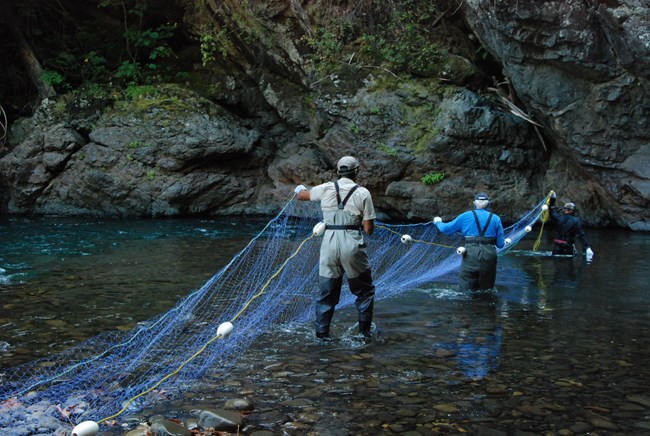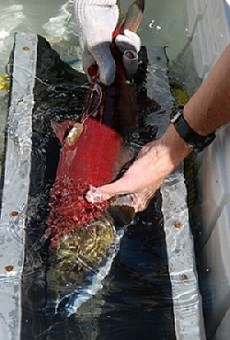
NPS Photo The Elwha River is transitioning from its dam-bound era to a river wild and free. The river was significantly altered by the dams, and biologists predict that it will take at least a generation—if not more—to recover. Scientists are continuously watching, measuring, monitoring and evaluating changes in an effort to better understand the mechanisms of river evolution. It is rare to get to watch a river reborn, and what we learn from the Elwha River Restoration Project will help to inform future dam removal projects and restoration strategies. RevegetationAlmost immediately following the removal of the Elwha and Glines Canyon Dams, scientists began implementing a major revegetation project to restore several hundred acres of formerly inundated reservoirs. The revegetation plan had three main objectives:

Restoration efforts revealed that areas of the lake bed with finer sediments had optimal conditions for revegetation, with those areas typically maintaining higher levels of nutrients and better retaining moisture relative to the more coarsely sedimented areas. Revegetation efforts have restored a diverse range of native plant species to the area, including Douglas fir, red alder, black cottonwood, western red cedar and Sitka willow, among many others. Areas with more coarse sediments became suitable habitat for species such as Oregon sunshine and riverbank lupine. Revegetating the area has facilitated numerous ecosystem benefits, including preventing erosion, improving soil quality, providing a place for pollinators, and creating habitat for birds and other organisms.
Collaboration between the Olympic National Park restoration team and the Lower Elwha Klallam Tribe was fundamental for accomplishing revegetation goals, with both groups providing critical funding, labor and supplies for the project. Both park and tribal researchers will continue to monitor restoration processes in the Elwha Valley to support full revegetation of the area and inform future projects.

FisheriesRemoval of the Elwha and Glines Canyon dams was critical in restoring the river to its natural state, once again giving fish access to more than 70 river miles of pristine spawning habitat protected within Olympic National Park. After being blocked from the upper reaches of the river for almost a century, salmon began returning to their natal waters upstream of the dams just months after dam removal. Using research methods such as snorkel surveys, radio telemetry and sonar imagery, biologists are monitoring how salmon are recolonizing the river. 
Though some species have shown strong signs of recovery, Pink and Chum salmon populations still remain critically low. Scientists will continue to monitor the recovery of the Elwha River’s anadromous fisheries to support full restoration of the ecosystem and inform future restoration efforts. Sediment and HydrologyDamming of the Elwha River dramatically reduced sediment flow to the coast leading to rapid erosion of the shoreline of the Elwha River delta. Removal of the dams has resulted in the release of millions of cubic yards of sand and silt to the nearshore waters of the Strait of Juan de Fuca. Specifically, sediment released during dam removal resulted in over a meter of sedimentation in the estuary and over 400 meters of expansion of the river mouth delta landform. Ongoing research efforts are assessing the restorative impacts of these renewed supplies of sediment on coastal ecosystems and habitats. Stream morphology monitoring efforts indicate that the river is now experiencing an overall trend of stabilization with regard to sediment load, turbidity and channel stabilization in the flood plains. The river will likely continue to change to an extent as revegetation progresses, and researchers will continue to monitor the progression of sediment transport and river stabilization. 
NPS Photos 
NPS Photo WildlifeThroughout their life cycle, salmon nourish over 130 species of insects, birds, fish, and mammals. Despite a general appreciation that salmon are key to sustaining many species of wildlife in the riverine environment, few studies have described the effects of salmon on wildlife diversity, abundance, or distribution patterns. This is largely because there have been so few opportunities for large scale experimentation and long-term studies. Prior to dam removal, the USGS, National Park Service, and Lower Elwha Klallam Tribe conducted baseline studies of wildlife distribution and species diversity patterns. These studies are providing a comparative baseline to evaluate the long-term effects of dam removal and watershed restoration on wildlife resources in the Elwha River ecosystem. Restoring wildlife in the post-dam removal era will require restoring both species presence and the key ecological functions provided by those species. In the first two years following dam removal, researchers detected numerous species, all of which represent natural recolonization and expanding wildlife distributions into terrestrial and wetland habitats that have been restored in the years since dam removal.Estuary and Coastal HabitatsThe Elwha River estuary is the primary location where freshwater from the Elwha River mixes with the coastal waters of the Strait of Juan de Fuca. This habitat provides an important refuge for juvenile salmon and other wildlife. Studies of the estuary are carried out in collaboration with the Lower Elwha Klallam Tribe, which owns and manages most of the estuarine complex. Recent research efforts have focused on determining how physical changes to the river delta and estuary habitats during dam removal were linked to responses in biological communities. Studies indicate that these physical changes reduced the abundance of macroinvertebrates and fish in the estuary and shifted community composition from brackish to freshwater‐dominated species. |
Last updated: March 28, 2025
